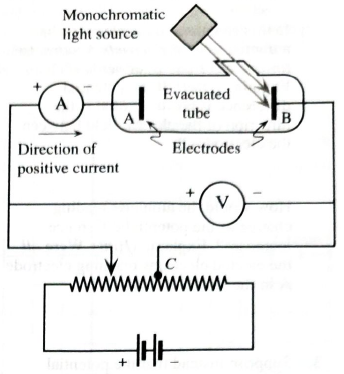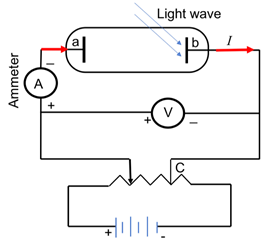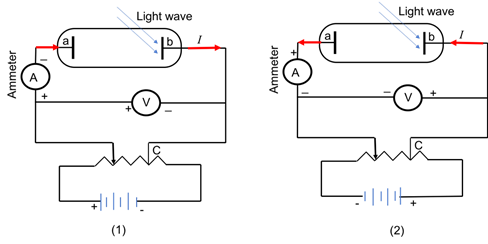
How does the voltmeter reading compare to the potential difference across the electrodes? Explain.
If the sliding lead from electrode A were connected at point C along the resistor, would the voltmeter reading be positive, negative, or zero? Explain.

(Hint: Imagine disconnecting the ammeter and evacuated tube from the rest of the circuit, and answering the same question.)
How would you adjust the sliding connection from electrode A in order to make the potential difference across the electrodes
The potential difference reading in the voltmeter.
Voltmeter reading positive, negative or zero.
To adjustment to be made for the Voltmeter reading as positive and negative.
Answer to Problem 1aT
The potential across the electrodes is equal to the potential difference reading in the voltmeter.
Voltmeter reading will be positive.
By reversing the direction of the connection of the variable battery voltmeter can read negative potential.
Explanation of Solution
Introduction:
Photoelectric effect: Electrons from a metal surface are ejected when a light of an appropriate frequency is incident on it.The ejected electrons are called photoelectrons and the whole phenomenon is called photoelectric effect. This effect was explained by The Albert Einstein.
Figure 1 shows the circuit diagram to study the Photoelectric effect (PE).

Figure 1: Set up to study photoelectric effect
A monochromatic is incident on one of the electrodes ‘b’ . Electron bonded to a metal requires a minimum energy just to leave the surface of metal is called binding energy of electron, also known as work function of the electron and denoted as
Current is flowing from positive to negative terminal of the battery (shown as red arrows in Figure 1).Therefore, the voltmeter will show the potential across electrode positive as electrons are flowing from high potential to lower potential.
Figure 2 shows the circuit diagram to study the Photoelectric effect (PE). In order to obtain the positive potentialdifference, read by voltmeter, figure 2(1) is applicable, as the electrode ‘b’ exposed to light is connected to negative terminal and other electrode ‘a’to the positive terminal of the battery. To make it more positive, one need to increase the potential of the variable battery that will make the electrode ‘a’more positive, hence will result in more positive potential across the electrodes.

Figure 2: Set up to study photoelectric effect
In order to obtain the negative potential difference,read by voltmeter, figure 2(2) is applicable, as the electrode ‘b’ exposed to light is connected to positive terminal and other electrode ‘a’to the negative terminal of the battery.
Conclusion:
The potential across the electrodes is equal to the potential difference reading in the voltmeter.Voltmeter reading will be positive.By reversing the direction of the connection of the variable battery voltmeter can read negative potential.
Want to see more full solutions like this?
Chapter 14 Solutions
Tutorials in Introductory Physics
Additional Science Textbook Solutions
Cosmic Perspective Fundamentals
Anatomy & Physiology (6th Edition)
Chemistry: An Introduction to General, Organic, and Biological Chemistry (13th Edition)
Chemistry: Structure and Properties (2nd Edition)
Microbiology: An Introduction
Campbell Biology (11th Edition)
- Ultimate Byleth and Little Mac fight. Little Mac, who is a boxer, dashes forward at 26.6 m/s, fist first. Byleth moves in the opposite direction at 3.79 m/s, where they collide with Little Mac’s fist. After the punch Byleth flies backwards at 11.1 m/s. How fast, and in what direction, is Little Mac now moving? Little Mac has a mass of 48.5 kg and Byleth has a mass of 72.0 kg.arrow_forwardMake sure to draw a sketch with scale as wellarrow_forwardMake sure to draw a sketch with scale pleasearrow_forward
- Kirby jumps towards his enemy/ally, Meta Knight, at 2.06 m/s while Meta Knight glides in the opposite direction (toward Kirby) at 5.06 m/s. Kirby then begins to inhale, swallowing Meta Knight. What is Kirby/Meta Knight’s velocity immediately after being swallowed? Please put the magnitude of the velocity and then mark direction using dropdown menu. Kirby has a mass of 0.283 kg and Meta Knight has a mass of 0.538 kg.arrow_forwardNo Aiarrow_forwardCan someone help mearrow_forward
- Need help on the following questions on biomechanics. (Please refer to images below)A gymnast weighing 68 kg attempts a handstand using only one arm. He plants his handat an angle resulting in the reaction force shown.A) Find the resultant force (acting on the Center of Mass)B) Find the resultant moment (acting on the Center of Mass)C) Draw the resultant force and moment about the center of mass on the figure below. Will the gymnast rotate, translate, or both? And in which direction?arrow_forwardPlease help me on the following question (Please refer to image below)An Olympic lifter (m = 103kg) is holding a lift with a mass of 350 kg. The barexerts a purely vertical force that is equally distributed between both hands. Each arm has amass of 9 kg, are 0.8m long and form a 40° angle with the horizontal. The CoM for each armis 0.5 m from hand. Assuming the lifter is facing us in the diagram below, his right deltoidinserts 14cm from the shoulder at an angle of 13° counter-clockwise from the humerus.A) You are interested in calculating the force in the right deltoid. Draw a free body diagramof the right arm including the external forces, joint reaction forces, a coordinate system andstate your assumptions.B) Find the force exerted by the right deltoidC) Find the shoulder joint contact force. Report your answer using the magnitude and directionof the shoulder force vector.arrow_forwardI need help with part B. I cant seem to get the correct answer. Please walk me through what youre doing to get to the answer and what that could bearrow_forward

 Glencoe Physics: Principles and Problems, Student...PhysicsISBN:9780078807213Author:Paul W. ZitzewitzPublisher:Glencoe/McGraw-Hill
Glencoe Physics: Principles and Problems, Student...PhysicsISBN:9780078807213Author:Paul W. ZitzewitzPublisher:Glencoe/McGraw-Hill College PhysicsPhysicsISBN:9781938168000Author:Paul Peter Urone, Roger HinrichsPublisher:OpenStax College
College PhysicsPhysicsISBN:9781938168000Author:Paul Peter Urone, Roger HinrichsPublisher:OpenStax College University Physics Volume 1PhysicsISBN:9781938168277Author:William Moebs, Samuel J. Ling, Jeff SannyPublisher:OpenStax - Rice University
University Physics Volume 1PhysicsISBN:9781938168277Author:William Moebs, Samuel J. Ling, Jeff SannyPublisher:OpenStax - Rice University
 Physics for Scientists and Engineers: Foundations...PhysicsISBN:9781133939146Author:Katz, Debora M.Publisher:Cengage Learning
Physics for Scientists and Engineers: Foundations...PhysicsISBN:9781133939146Author:Katz, Debora M.Publisher:Cengage Learning





